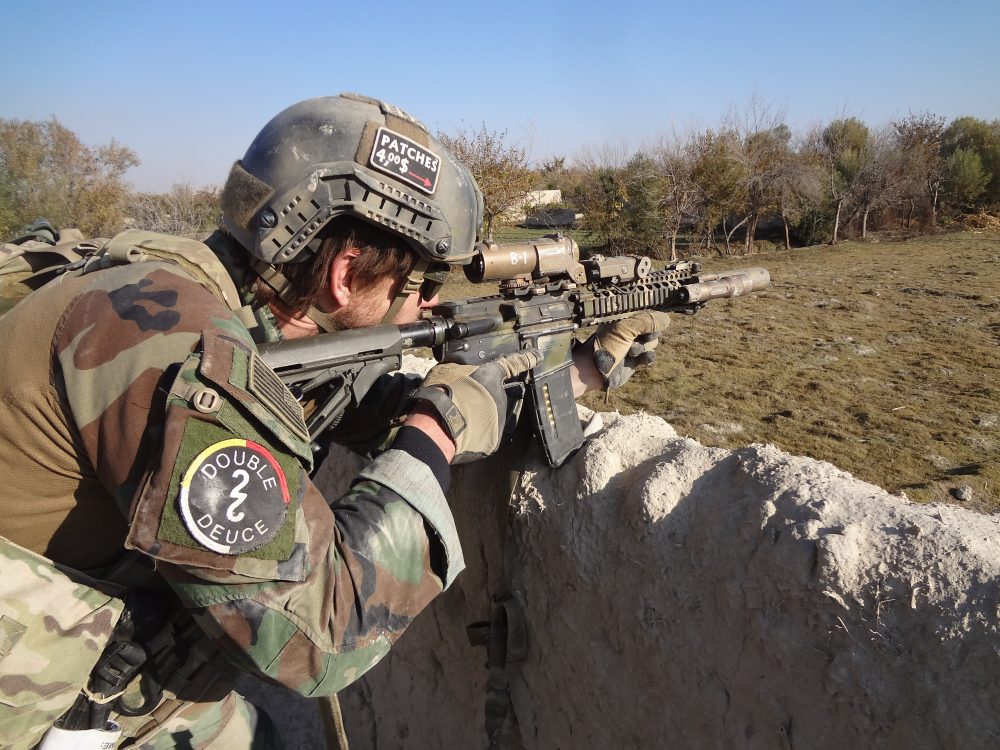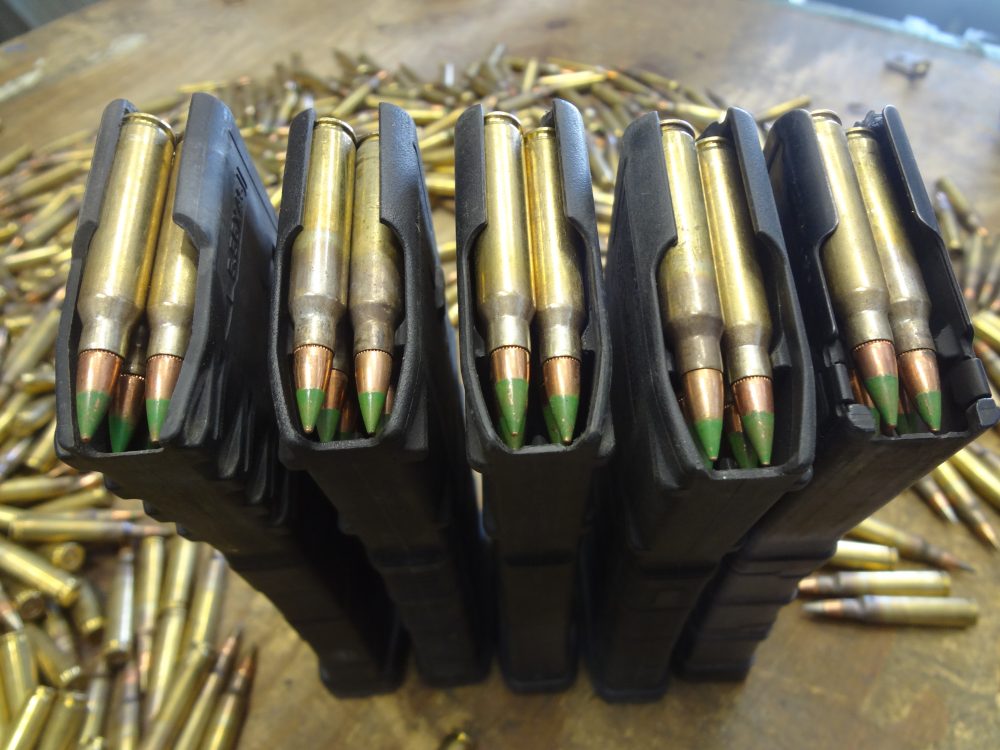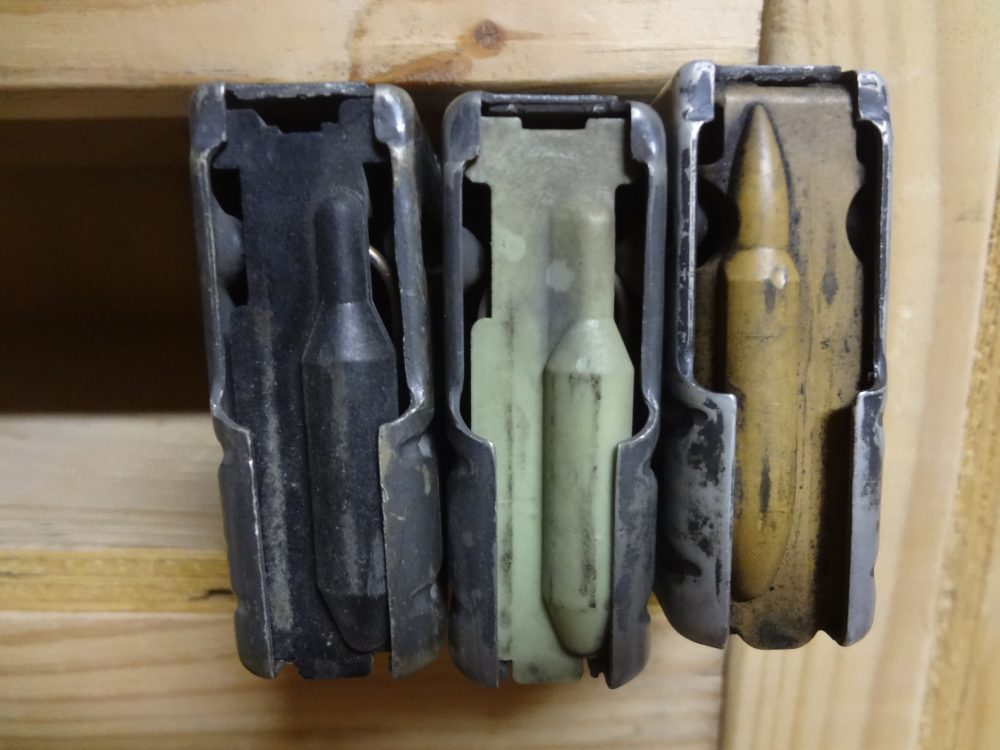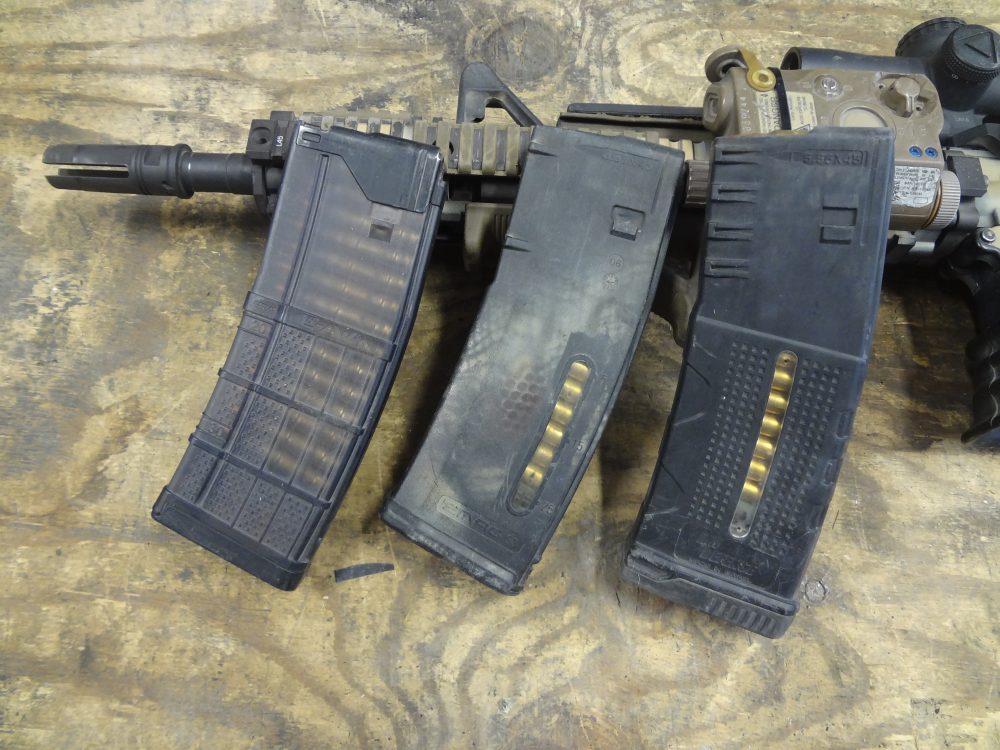Don’t let a myth stop you from using a good technique. Despite what you may have heard, resting your magazine on something to get more stable will not “jam up” your rifle. If you do have problems, it’s because it’s a faulty magazine.
No matter how much money you spend on an AR, if you want it to run reliably, you must use quality magazines. This sounds like common sense, but many times I have found shooters using old, worn-out or low-quality magazines. It’s frustrating to watch a shooter fight through clearing a double feed only to re-insert the same magazine, potentially setting himself up for another double feed. (Not the ideal technique in the middle of a gunfight.)
Rifle magazines are one of those items where every shooter seems to have their favorites. This makes sense—when you’ve had a good experience with an item and it works well, why not stick with it?
Rather than going over what I think are the best magazines—since shooter reviews covering every magazine currently available exist both in print and online—I’d like to discuss what you should look for in a quality AR magazine.
Knowing what right looks like can save you money. Getting surplus mags for $5 each saves you nothing if you end up having to turn around and buy other mags later because they do not run. (Buy cheap, buy twice.)
By using quality magazines to begin with, if you do have feeding issues with your rifle, being able to discount the magazine can save time and effort trying to determine if it’s a loading or chambering issue.
Three aluminum magazines. On the left, what the front folds of a magazine should look like, being evenly pressed together. The center and right magazines … not so much. With the center magazine, due to the depth of the metal’s fold into the inside of the magazine, rounds were dragging and getting caught up on it. This resulted in numerous malfunctions and made it an unusable magazine.
Table of Contents
WHAT TO LOOK FOR
Many think the most important item on a magazine is the follower. While a smooth, good-working anti-tilt follower is a key item, it’s not the only piece required for a well-functioning magazine.
The body and overall construction of the magazine are just as important. Everything from the design of the feed lips to what the magazine is made of plays a part in the overall reliability.
What should you scrutinize to determine if you have a well-built magazine? Whether you use aluminum- or polymer-bodied mags, the areas you need to look at are the same. But what the magazine is made out of determines what you are specifically looking for in those areas.
For metal magazines (aluminum or steel), usually the body of the magazine itself consists of two pieces of metal joined at the front and back (both pieces overlapped and pressed together). How the metal is joined at the front of the magazine (bullet tip side) is the area you need to examine.
If not joined correctly, you can have issues with the rounds being able to feed up while inside the magazine, as the nose of the rounds can drag on the inside of the front wall.
Two polymer magazines and a GI aluminum. Due to the thickness of the front wall on the far left magazine, the nose of the rounds catch on it. Close inspection reveals two impressions where they have been catching on it. Center polymer magazine had no issues and enough room for all types of 5.56mm ammunition.
Looking straight down at a metal magazine, the two pieces that join and overlap on the front should be even against each other. If the two pieces are unevenly pressed together, the inside flap of metal can protrude into the magazine itself. (This is basically a sloppy construction job.) If the tips of the rounds are touching this metal fold, they can drag on it on the inside of the magazine.
The result are failures to feed because the rounds are just not feeding up so the bolt carrier can pick them up, or failures to chamber because the nose of the bullet is touching the inside front lip. The extra pressure it takes to strip the round out of the magazine takes away from the force of the recoil spring to push it forward to fully seating in the chamber.
The same problem can be found with some polymer magazines (nose of rounds touching the front wall of the magazine), the issue having to do with the thickness of the walls of the polymer magazine body itself. On some of these mags, the front inside wall is thicker, leaving less room for the tips of the round. This leads to the same feeding issues as with poorly joined metal magazines.
Three different aluminum magazines loaded with MK262 77-grain. Feed lips play a part in determining how high the nose of the rounds sits above the front wall of the magazine. Not enough clearance and your rounds may catch on the front lip of the magazine during the loading process. Center magazine has minimal amount of clearance. Magazine on the right, made by FNH for the 5.56 SCAR Light, has space cut out for the nose of the round, to ensure no issues.
.223 AND 5.56MM: NOT THE SAME
Usually if there is an issue with either the front wall being too thick or not enough clearance for the nose of the round to clear the edge, it is with military ammunition. The reason for this can be found in the variances between .223 and 5.56mm bullet tips. Although it takes a micrometer to measure, there are slight differences in the length of the rounds depending on their manufacture, bullet weight, and type (hollow points, match grade).
I have a few polymer magazines that only have feeding issues with military MK262 77-grain ammunition. Even though it’s slightly shorter than your average 5.56mm round, MK262s have a flat tip with a hole in the nose of the round. (The purpose is to help stabilize the round in flight—not expansion like a hollow point.) The MK262 flat tip catches on the front lips of certain magazines, leading to chambering issues.
The reason why some brand-name magazines do not run well with military ammunition could be that they have been built around and tested using only civilian ammunition. I have used some metal magazines with poorly joined pieces, and they still run great with civilian ammo.
As a soldier, I personally do not trust or use any magazines that cannot reliably run all types of ammunition. I do not want to have to separate magazines between personal use and military work.
With today’s modern manufacturing techniques, there should be no reason why all magazine manufacturers cannot make magazines that reliably run all ammunition they were designed for.
Five different polymer magazines. Polymer feed lips can wear out over time with hard use. Of the magazines pictured here, only the Lancer L5 Advanced Warfighter has metal feed lips.
FEED LIPS
Moving up the magazine, the next item to look at is the feed lips. How important are they? If you have a magazine with a substandard follower, it will most likely run for a little while, or at least allow a few rounds to feed before sticking and jamming up. But if you have damaged feed lips, you might get no more than one round off (if that) before feeding issues occur.
Looking at the feed lips, what is important is how much clearance the rounds have above the front wall of the magazine. If you take a loaded magazine and look at it from the front (looking at the nose of the bullets), the top rounds sitting up against the feed lips, the nose of the rounds should have plenty of clearance above the front wall of the magazine, in particular the first round on the left as you look at it from the front (or the round on the right looking down on it as you normally would).
If the rounds do not have enough clearance above the front wall of the magazine, the nose of the rounds can catch or drag on the edge of the front wall of the magazine, leading to chambering issues. The extra energy it takes to strip the round off the edge of the magazine lip takes away from the bolt properly seating the round all the way in the chamber.
Because energy was robbed from the recoil spring in the loading process, the round will be only partially stripped out of the magazine, with the nose of the round usually somewhere on the feed ramp, looking like a chambering problem.
U.S. Military issue magazines, from left to right: 1980s-1990s with black follower; late 1990s green follower magazine, which had some anti-tilt design to it; and current issue improved magazine with tan follower. With the tan follower, bullet protrusion is on the left. This puts the 30th round loaded in the magazine on the left and different than any other AR mag.
FEED LIP CONSTRUCTION
This is where using metal or polymer can make a difference. The biggest issue with aluminum or steel mags is the danger of them bending, usually from dropping them on a hard surface.
This was recognized a long time ago, hence you can purchase metal molding tools designed for you to be able to reshape your metal feed lips back into the proper shape and angle.
One benefit of polymer magazines is the polymer feed lips will flex some before breaking. There’s less chance of damaging the feed lips when dropping a polymer magazine on a hard surface as compared to an aluminum magazine.
Three followers from military-issued magazines and a Magpul Enhanced Self-Leveling Follower at far right. Compared to the old black follower, you can see the efforts to both lengthen and thicken parts of the follower to keep it from tilting in the magazine.
The downside to polymer feed lips is they can wear out via becoming somewhat malleable and allow rounds to slip past them. I have experienced this mainly while serving overseas in hot climates. Running around in 100 degree plus temperatures and having to shoot over an extended period of time (multiple magazines), the rifle tends to get pretty damn hot.
After going through this a few times, the feed lips can develop some slight flex to them, allowing rounds to easily slip out. This can lead to double or triple feeds, because they allow more than the one round the bolt is stripping off to pop out into the chamber.
Although I would not say it’s a definitive indicator, if you store your magazines rounds down in the pouches—which you should for the fastest reload—and you start to find loose rounds at the bottom of the pouch, it could be a sign of weak feed lips.
Almost every modern magazine manufacturer offers their own version of an anti-tilt follower with their magazines. Only old GI surplus magazines and some imitation knock-offs don’t have it.
THE FOLLOWER
Around 1998 I first got some of the new (at the time) GI magazines with green anti-tilt follower. Up until then, all our magazines had the black plastic follower, basically the same design used since Vietnam.
A note on just how bad some of these black follower military-issued magazines were. Prior to any real-world deployment, I test fired all my magazines. It always seemed out of a dozen or so, I’d have one or two that did not run well. (These I would trash.)
An anti-tilt follower works by keeping the rounds level as they feed up to the top of the magazine. Specifically during rapid firing a cyclic full-auto, the black follower sometimes moved unevenly up and down within the magazine. This leads +either to the nose of the rounds or the back of the cartridge hanging up during the loading processes.
This uneven feeding can also cause rounds to slip up past the feed lips during the loading cycle, causing double feeds. The good news is just about every manufacturer of magazines today has a version of an anti-tilt follower in their magazines.
Author’s preferred magazines, based on overall design and long-term reliability. From left: Lancer L5 AWM, IMI Defense G2 and Magpul EMAG.
To check your followers, simply push down on them with finger pressure. The follower should move up and down smoothly inside the magazine. You will notice some anti-tilt followers have zero play and will only go down evenly on both ends, while others have some play. If your followers have a little tilt in them, that is OK, as long as you cannot push down one end so far that the follower sticks at a sharp angle and is stuck in the magazine.
I would like to comment on the magazine catch and the ability for the magazine to drop free. Bottom line is, if the magazine does not drop free without the need to pull on it, I do not deem it serviceable. If metal magazines do not drop free, the body of the magazine might be slightly warped or the magazine catch slot might be damaged in some way.
For polymer magazines that do not drop free, diagnosing why can be a little more involved, because of their variances in thickness and texture.
Depending on how milspec the magazine well on your rifle is, some might not drop free at all. This is why I really like the Magpul EMAG. They were specifically designed to fit the tighter mag well of the H&K 416. Because of this, they are guaranteed to fit and fall free in most other ARs.
Of these four magazines, three are loaded properly and one is not. Can you tell by looking which one is not? Before the adoption of the “improved” tan follower GI mag, the rule was the last round always sits on the right. On the far right is the improved tan follower mag. Next to it is an overloaded polymer magazine.
METAL OR POLYMER?
Which is better, metal or polymer mags? Both have their pros and cons. I personally prefer polymer magazines for a few reasons. First, a lot of polymer-type magazines have a window in them or are translucent enough that you can see the rounds. Being able to glance down and estimate how many bullets are left in your magazine is great for when you are trying to gauge when to perform a tactical reload.
Second, and this is minor, but the corners on aluminum mags can be tough on your magazine pouches, depending on what type you use. Most polymer mags have soft edges that are easier on your pouches.
Last, most polymer magazines have raised portions or texturing specifically designed for better gripping—a handy feature when trying to reload rapidly!
PET PEEVES, MYTHS, AND WORN-OUT MAGAZINES
Two issues that really bother me are related, even though one has to do with the new GI tan follower magazine, and the other is generally seen only with polymer magazines. They are related because they both have to do with what a properly loaded magazine is supposed to look like.
Something I see a lot at the range, with both civilian and military shooters, is overloading magazines to 31 rounds. When you cram an extra round in a magazine, there is no give in the tension of the rounds under the feed lips. The result is you cannot properly seat the magazine in the magazine well, with the catch locking the mag in place on a closed bolt.
Generally what happens is a shooter walks up to the firing line and slaps the magazine in (it stays in place via the catch but is not locked in). Shooter racks the bolt, loading nothing because the feed lips are not seated close enough to the bolt. He pulls the trigger and “click,” the hammer falls on nothing—and usually the mag falls out because the vibration from the hammer is enough to undo the partial mag catch in the magazine.
While it can be a great source of entertainment to watch a shooter at the beginning of a course of fire pull the trigger on his rifle only to hear a click, it’s not something you want in a tactical or defensive situation.
To ensure you do not do this, many will say, “When loading magazines, your last round should be on the right.” Here is the problem: with the new “improved” GI magazine with tan follower, the last round sits on the left. This is counter to just about every other 5.56 magazine on the planet.
All magazines are not created equal. Make sure yours function properly.
Now it’s not that big of a deal if they are the only mags you use, as all the last rounds sit on the left. But what about the Soldier who has some mags with the tan follower and others that are the older green ones? Now when they are all loaded up, he cannot tell by looking at them if they are properly loaded. Some will be last round left, some right.
I find this very annoying, because one of the signs your magazines are wearing out is if they start allowing a 31st round. As you can imagine, this can get confusing. How does this relate to polymer magazines? There are some (even brand new, just out of the wrapper) that allow an extra round and will not properly seat on a closed bolt. As far as I know, the GI aluminum magazine with tan follower is the only mag where the last (30th) round sits on the left.
On to some myths. Here are two that relate to the magazine spring: First is that you should only load mags to 28 rounds to ensure they run correctly and the spring does not wear out prematurely. Second, while shooting from prone, never rest the magazine on the ground because you can cause a feeding issue as too much tension on the rounds pushes down on the spring.
At one time this may have been true for both, but I mean Vietnam era or Army GI black follower magazines. Today a quality magazine can and should be able to be loaded and stay loaded with 30 rounds for a long time. I have some GI green follower mags from the late 1990s that I have used fully loaded on numerous deployments, and they still run great.
As far as putting pressure on a mag while shooting prone—using it as a monopod—if your magazine does not work when you do this, it’s because the magazine is worn out or faulty. Various aftermarket accessories can be added to magazine base plates to give the magazine a better, more stable base while using it as a monopod.
How can you tell if you have worn-out magazines, aside from loading them up and seeing if you can cram extra rounds in them from the spring getting weak? As soon as you start having any sort of stoppage. As I mentioned earlier, most double feeds are due to the feed lips getting weak or some follower issue. When I get a double feed, I usually throw that magazine away.
But if you do not have an endless supply of AR mags, I suggest numbering all your mags. If you have a double feed, annotate what mag it was and shoot it again. If you get yet another double feed, you definitely know it’s the magazine and it’s time for it to go!
THE WRAP-UP
Whether you are shooting in a match or on the battlefield, do not trust your reliability to your uncle’s leftover magazines from the first Gulf War.
Knowing what a quality magazine looks like and when it starts to wear out can make the difference between winning and losing in whatever situation you are relying on your AR to handle for you.
Jeff Gurwitch has 25 years military experience, the past 17 with U.S. Army Special Forces. He served in the first Gulf War, three tours both in OIF and OEF. He has been a competitive shooter for over a dozen years, competing in USPSA, IDPA, and 3-Gun.

















